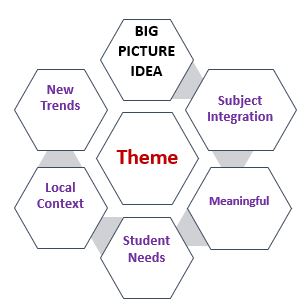We live in a VUCA WORLD!
The world is Volatile, Uncertain, Complex, and Ambiguous, and it will be even more complicated in the future!
The stakeholders in Education are trying their best to equip the young generation to deal with the ever-changing world. Much talk is happening in conferences, seminars, and forums where new programs, models and approaches are unveiled and discussed; however, the impact is superficial and temporary.
What are we missing?
We are trying to solve a severe problem without hitting its core! The problem is with the fundamental design of the existing curriculum; we are trying to conceal it by wrapping a fancy cover on it!
For years, all the school subjects have been taught as distinct disciplines with almost no cross-linking. As a result, students have always struggled to find connections between them; hence they fail to visualise the big picture.
Consequently, they cannot extend their learning beyond the four walls of the classrooms. This is called the ‘Loss in transfer of Learning’ when children possess the factual knowledge to pass formal exams but lack the aptitude to apply their knowledge for complex problem-solving.
Visualising Rainbows through Education
We all have seen rainbows; they look fascinating indeed! Rainbows are a true representation of positive energy, joy and colours in our life. However, a curious educator in me started looking into rainbows through a different lens. I pondered over and over and finally asked my students,
“What if you see only one colour in a rainbow? Will it still be a treat to your eyes?”
“What if you see these colours scattered here and there in the sky but not as a rainbow? Will it make any sense to you?”
Their affirmations strongly resonated with my perception of rainbows.
“It is the combination of colours that gives meaning to a rainbow.”
We need to guide children to make connections between their learning experiences to be able to imagine the Big Picture!
It is a holistic approach to education in which the curriculum is designed, taught and assessed in an integrated way.
In this approach, the content becomes the means to an end, not the end itself! The process of learning is given equal importance as the outcome of it.
Conclusively, the integrated curriculum leads to Meaningful, Engaging and Fun-filled learning called ‘The Rainbow Experience.’
Diving deeper into the Integrated Curriculum
An authentic, integrated curriculum completely dissolves the boundaries of subjects. Instead, the topics are woven into ‘Themes’, taught through relevant sub-themes.

How many of us still remember the topics and subjects we studied in primary school? We rarely do!
A theme-based curriculum empowers children to understand the context, not just the text! It helps in knowledge retention throughout their lives.
Curriculum designers and teachers must remember these key points while developing a Theme-based curriculum.
The theme should:
- Involve the integration of subjects.
- Be meaningful for students.
- Meet student needs and local context.
- Connect student learning to new trends.
- Lead to a big-picture idea!

Teachers hold the ‘Magic Wand’
Have you ever walked into a classroom but felt like you were in a jungle, a garden or a galaxy? If so, the teacher was using Theme-based teaching and bringing the curriculum to life and, at the same time, bringing life into the curriculum!
Teachers need to look for themes that cater to learners’ needs. Think about their culture, the community they belong to, their learning styles and interests. Incorporate themes about skills and values you want your students to develop, events you celebrate, and topics that reflect what’s happening in the world around you.
Students sit in the Heart of Theme-based Teaching
Create themes that represent the children in your class. Whether designing, implementing or assessing the curriculum, every activity should be relevant and meaningful to the learner.
Children have an innate tendency to learn anytime and anywhere. Therefore, schools and teachers must facilitate their learning journey so that they learn all the time and everywhere! The primary purpose of a theme-based curriculum should be to equip children with information-processing, problem-solving, critical thinking, and creativity skills. However, it will be a significant leap if we can develop attitudes that guide our early learners in transferring their skills to solve real-world problems.
An integrated curriculum should be designed, implemented, and assessed with innovative and collaborative approaches.
Designing the Curriculum
- Choose some prominent themes related to a compelling real-life issue.
- Add new themes each year based on the trends or topics about what’s happening in the world around you.
- While designing the theme-based curriculum, collaborate with teachers all the time! Such a curriculum can’t be developed and taught in silos.
- Involve students in co-creating themes by conducting student surveys, reflections, and polls. Hence, they will be able to connect with the goals and the outcomes of learning.
Implementing the Curriculum
- When teaching the theme-based curriculum, include inquiry, hands-on learning, field trips, and interaction with the community and the real world.
- To apply conceptual understanding, let students collaborate and innovate to design projects that solve problems around them.
- Plan flexible learning activities to cater for the developmental needs of learners.
- Since a single textbook can’t teach such a curriculum, provide your students with various resources that help build an understanding of the theme.
Assessing the Curriculum
- Assess and evaluate student progress throughout the thematic unit.
- Measure student understanding through formative assessment, self-assessment and peer assessment.
- Use various assessment tools such as observations, checklists, rubrics, portfolios, mind mapping, reflections, feedback, etc.
“Are you all set to create ‘The Rainbow Experience’ for your students?”
To empower the next generation with values, skills, and attitudes to solve future challenges, educators need to start thinking differently and collaborate towards reimagining and recreating innovative designs of curriculum and pedagogy.
To develop a complete mind…
-Leonardo Da Vinci
“Learn how to SEE. Realise that everything connects to everything else.”



after reading this, I really remembered how you used many of these techniques while you taught us chemistry,
for instance, using multiple resources and books to help us get the full in-depth view of the chemistry o-level curriculum, and till this day chemistry has been piece of cake to me as I gained the full image of the foundations of solving any chemistry question I could possibly face,
fun fact: I still use your techniques in college
thanks, Dr. Abilasha,
I will always remember how great of a teacher you are ❤️
LikeLiked by 1 person
I am overwhelmed to get a great feedback from one of the outstanding students I have taught!
Thank you Joud!
I truly believe teachers should be lifelong learners and they need to engage their students with innovative approaches!
We should teach the CONTEXT and not just the TEXT!
LikeLike
Thank you. Thrilled to read this as I am grappling with the idea of realising the institutional core values (read, themes) cutting across the disciplines and school activities. So we identified the core values to be realised are to be caught through subject teaching, habits being inculcated, physical education, SEWA, class and school assemblies, observance of significant days so on… But finally, the magic wand is in the hand of the teachers. How to make them realise this is the task. The next is autonomy in exploring and executing the ways and means at teacher and school level. The school, in general, is under severe regimentation with targets to be achieved and papers to be filed, and very minimal incentives for innovation other than the satisfaction one derives from having tried or achieved something.
LikeLike
Thank you so much for your feedback.
Yes indeed, teachers hold the magic wand! They should feel passionate about the change they can bring!
However, I believe if school administration supports with a school policy, learning frameworks, ease of collaboration for theme-based planning, resources would be great!
LikeLike